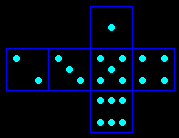the polyhedral dice
Let's begin with the classical cubic die which exists in different variants!
The six faces are marked with 1 to 6 points, in order to have the sums of opposite faces equal to 7 = 1+6 = 2+5 = 3+4.
Only the faces 1, 4 and 5 hold their order 4 symmetry; so we can get different variants of this type of die by changing the orientations of the marks on the three other faces, by exchanging the faces 1 and 6 ...
There are also cubic dice with card's symbols (nine, ten, Jack, Queen, King and Ace). |
|
 |
But all dice are not cubic! A "fair die" must have the same probability to land on each of its faces. To be a "fair die" a solid must:
• be convex and made out of an homogeneous material,
• have identical faces which play the same role in the polyhedron, and thus have the same relationship with its center of gravity
(the mathematicians say that the symmetry group acts transitively in the set of faces, thus we have only one orbit: for each pair of faces there is a symmetry which transforms one into the other).
First let's notice that a polyhedral die has at least four faces. But with non planar faces we can make dice Dn with any number n of faces:
| D1 : |
a sphere (what may be the usage of such a die!), |
| D2 : |
a lens, or a token (circular or regularly polygonal), |
| D3 : |
spindle-shaped which can be made by distorting a regular triangular prism in order to reduce each of the two bases to a point, |
| Dn : |
(n > 3) regular prisms of order n tapered at both ends; this is the only way to make "fair dice" with odd numbers of faces. |
Using Euler's formula, Klaus Æ. Mogensen (see reference) showed that there exist 29 types of dice (included the three above). The faces of the 26 types of polyhedral dice are triangles, quadrilaterals or pentagons. Some are topologically equivalent: for example we can stretch a cube to build a rhombohedron which may then be twisted; there exist equifacial non regular tetrahedra and dodecahedra ...
The number of basic polyhedral types is only 18. We immediately think about the regular polyhedra, and the semi-regular polyhedra of second kind complete the list. Finally we have:
• the regular tetrahedron, dodecahedron and icosahedron,
• the 13 Catalan's polyhedra,
• the regular diamonds (among which the regular octahedron) and the regular anti-diamonds (among which the cube).
They have all an even number of faces tangent to an inscribed sphere.
If we require opposite faces (one on which the die stops, and one on which appears the result
of the throw) the list is shortened; in particular we have to discard the regular tetrahedron, the diamonds of odd order and the anti-diamonds of even order.
Concerning the possible numbers of faces, we thus have:
D4, D6, D8, D12 and D20 (regular polyhedra),
D12, two D24 and two D60 (triangular faces, regular polyhedra with regular pyramids on their faces),
D12 and D30 (rhombus faces),
two D24 and two D60 (pentagonal and kite-shaped faces),
D48 and D120 (triangular faces, D12 and D30 with pyramids on their faces),
and two infinite sequences D2n (triangular faces for the diamonds and kite-shaped for the anti-diamonds).
 |
 |
It's hard to imagine polyhedral dice with non identical faces, nevertheless...
Here are two ways to theoretically make dice with any numbers of faces. Let b and f be the probabilities that a die stops on a base or a lateral face; then, for a regular pyramid or prism of order n we have respectively
b + nf = 1 (n+1 faces) and 2b + nf = 1 (n+2 faces).
Generally b and f are different; more precisely, if h denotes the height and r the base's diameter,
h << r leads to f < b and r << h leads to b < f.
By continuity there must exist values for h and r so that b=f! Then each face of such a polyhedron has the same probability to appear after a throw. So we can find a D7 which is an appropriate pentagonal prism.
This way of reasoning works with other continuous transformations such as vertex truncations of the cube and the regular dodecahedron; they produce respectively 8 and 20 hexagons (non regular), which leads to a a D14 and a D32 (similar to a "soccer ball").
But are these non equifacial polyhedra really "fair dice"?





